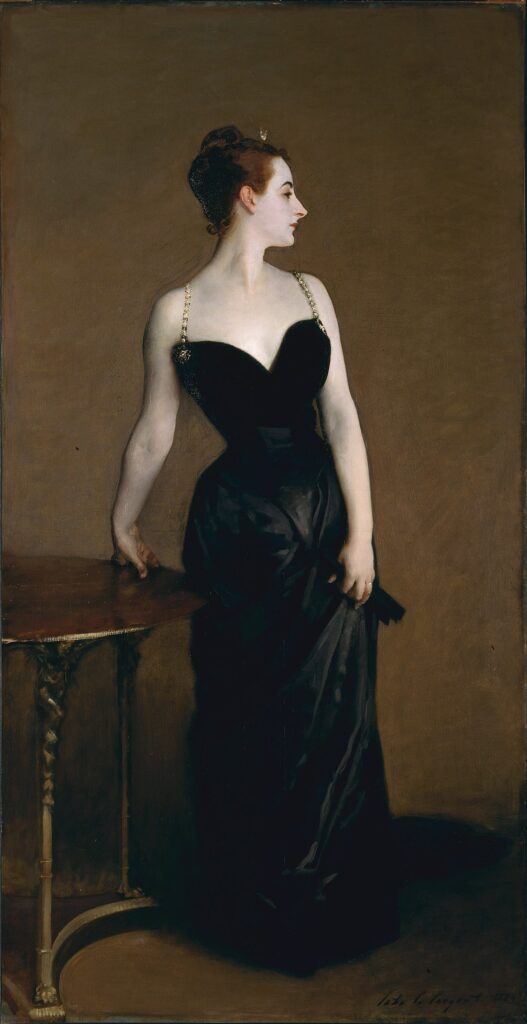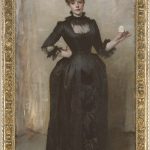
When we think of John Singer Sargent, one painting often stands out above the rest: the enigmatic and provocative “Portrait of Madame X.” This painting, more than any other, cemented Sargent’s reputation and stirred controversy in the art world. But who was Madame X, and what is the story behind this scandalous portrait? Let’s dive into the life of Virginie Amélie Avegno Gautreau and explore how her striking image came to be immortalized by Sargent.
John Singer Sargent: A Prodigy in the Making
Born in Florence in 1856 to American expatriates, John Singer Sargent grew up in a cosmopolitan environment, traveling extensively across Europe. This eclectic upbringing exposed him to various cultures and artistic styles, nurturing his prodigious talent. By the time he enrolled in the École des Beaux-Arts in Paris, Sargent had already developed a remarkable skill in portraiture.
Sargent’s early works were characterized by their technical brilliance and keen observation. He quickly gained a reputation for his ability to capture the essence of his subjects, blending realism with a unique sense of dynamism and personality. His talent caught the attention of the Parisian elite, leading to numerous commissions and establishing him as a sought-after portrait artist.
The Artistic Landscape of the Late 19th Century
To fully appreciate the impact of Sargent’s work and the scandal surrounding “Portrait of Madame X,” it’s essential to understand the artistic context of the late 19th century. This period was marked by significant changes and tensions in the art world, with traditional academic styles clashing with new, avant-garde movements.
The Paris Salon, the official art exhibition of the Académie des Beaux-Arts, was the pinnacle of the art establishment. Acceptance into the Salon was crucial for any artist seeking recognition and success. However, the Salon was known for its conservative tastes, favoring historical and mythological subjects rendered in a highly polished, academic style.
Against this backdrop, movements like Impressionism were challenging the status quo. Artists like Claude Monet, Édouard Manet, and Edgar Degas were experimenting with new techniques and subjects, focusing on contemporary life and the effects of light and color. Their work often faced harsh criticism from the establishment, but it also attracted a growing number of admirers.
Sargent’s style was somewhat of a bridge between these two worlds. His technical skill and attention to detail aligned with the academic tradition, but his dynamic compositions and modern subjects resonated with the more progressive elements of the art world. This duality made him a unique figure in the artistic landscape of his time.
Meeting Virginie Amélie Avegno Gautreau
Virginie Amélie Avegno Gautreau, known as Madame X, was born in New Orleans in 1859. After her father’s death in the Civil War, her family moved to Paris, where she became part of the city’s high society. Known for her beauty and charm, Virginie quickly gained a reputation as a socialite. Her striking appearance—pale skin, dark hair, and distinctive profile—made her a subject of fascination and desire in Parisian circles.
Virginie was known for her unconventional beauty routines, which included the use of lavender powder to achieve her signature pale complexion. Her fashion choices were equally distinctive, often pushing the boundaries of what was considered acceptable in Parisian high society. Her daring style and enigmatic presence made her a muse for several artists of the time.
Sargent first encountered Madame X in the early 1880s. Fascinated by her beauty and the aura of mystery surrounding her, he was determined to paint her portrait. Virginie, aware of her allure and the impact her image could have, agreed to sit for Sargent, setting the stage for one of the most famous portraits in art history.
The Making of “Portrait of Madame X”
Creating the “Portrait of Madame X” was no simple task. Sargent sought to capture not just Virginie’s physical beauty but also the enigmatic quality that made her a captivating figure. He experimented with numerous poses and compositions, striving to find the perfect representation of his subject.
The final portrait depicts Madame X standing in profile, wearing a black satin gown with jeweled straps that contrast sharply against her pale skin. Her pose is confident, almost defiant, with one hand resting on a table and the other hanging gracefully by her side. The background is dark and subdued, ensuring that all attention is focused on Virginie’s striking figure.
Sargent’s meticulous approach to this portrait is evident in the numerous preparatory sketches and studies he made before completing the final work. He spent months perfecting the composition, making frequent adjustments to capture the exact look and feel he envisioned. His dedication to this project highlights the importance he placed on this portrait, seeing it as a defining work in his career.
The Unveiling and Scandal at the Paris Salon
When Sargent unveiled the portrait at the Paris Salon of 1884, the reaction was explosive. The painting was considered scandalous, not just for its bold composition but also for the provocative nature of Madame X’s pose and attire. Critics and the public were shocked by what they perceived as an overly sensual depiction, and the painting quickly became the talk of Paris.
The controversy was fueled by several factors. First, the portrait’s composition was daringly modern. Madame X’s pose, with her head turned in profile and her body facing forward, exuded confidence and defiance. Her gown, with its plunging neckline and jewelled straps, was seen as scandalously revealing, especially by the conservative standards of the time.
Additionally, the painting’s original presentation included one of the jeweled straps of Madame X’s gown slipping off her shoulder. This detail was particularly provocative, suggesting a sense of dishevelment and intimacy that was deemed inappropriate for a public portrait. The combination of these elements created a sense of unease and disapproval among the viewers at the Salon.
The Personal and Professional Fallout
The controversy surrounding the “Portrait of Madame X” had significant repercussions for both Sargent and Virginie. Sargent faced harsh criticism, with many accusing him of vulgarity and impropriety. The backlash was so severe that it affected his reputation and led him to consider leaving Paris for London.
For Virginie, the scandal was equally damaging. Her reputation as a socialite suffered, and she became the subject of gossip and ridicule. The portrait, intended to immortalize her beauty and elegance, had instead brought unwanted notoriety.
In response to the public outcry, Sargent made a subtle but significant alteration to the painting. Originally, one of the jeweled straps of Madame X’s gown had slipped off her shoulder, adding to the sensuality of the image. Sargent repainted the strap in its proper place, a concession to the critics who had deemed the original version too provocative.
Despite this adjustment, the damage had been done. Sargent decided to move to London, where he hoped to find a more receptive audience for his work. This move marked a new phase in his career, allowing him to rebuild his reputation and continue to develop his distinctive style.
Rediscovery and Reassessment
Despite the initial scandal, the “Portrait of Madame X” eventually came to be recognized as a masterpiece. Over time, critics and the public reassessed the painting, appreciating its technical brilliance and the psychological depth of Sargent’s portrayal. The scandal that once tarnished Sargent’s reputation now seemed to underscore his boldness and innovative spirit.
In 1916, Sargent sold the portrait to the Metropolitan Museum of Art in New York, where it remains one of the museum’s most celebrated works. The painting, now simply titled “Madame X,” is viewed as a landmark in portraiture, showcasing Sargent’s mastery and his ability to capture the complexity of his subjects.
The Mysterious Woman Behind the Portrait
Virginie Amélie Avegno Gautreau’s life continued to be marked by her association with the portrait. Though the scandal had a lasting impact on her social standing, she remained a prominent figure in Parisian society. Her beauty and charm continued to captivate those around her, and she maintained a circle of influential friends and admirers.
Virginie’s enigmatic presence in the “Portrait of Madame X” invites endless speculation and interpretation. Was she a victim of societal double standards, punished for her confidence and allure? Or was she a willing participant in a bold artistic experiment that pushed the boundaries of conventional portraiture?
One thing is certain: Virginie was more than just a passive subject. Her collaboration with Sargent suggests a mutual understanding and a shared vision. Both artist and muse were aware of the provocative nature of their endeavor, and both faced the consequences with a certain resilience and dignity.
Sargent’s Legacy and Madame X’s Enduring Appeal
John Singer Sargent’s legacy as one of the greatest portrait artists of all time is firmly established. His ability to capture the essence of his subjects with both technical precision and emotional depth set him apart in the world of art. The “Portrait of Madame X,” once a source of scandal, is now celebrated as a testament to his genius and his willingness to challenge societal norms.
Madame X, as immortalized by Sargent, continues to captivate viewers with her enigmatic beauty and poise. The painting remains a focal point of discussion and admiration, embodying the timeless allure of mystery and elegance. Virginie’s portrayal transcends mere representation; it invites us to contemplate the nature of beauty, identity, and the power dynamics between artist and muse.
The Evolution of Artistic Perception
The story of Sargent and Madame X highlights the evolving nature of artistic perception and societal standards. What was once considered scandalous and inappropriate can, over time, come to be seen as bold and innovative. The initial backlash against the “Portrait of Madame X” was rooted in the conservative values of the time, which dictated strict norms for female representation in art.
Sargent’s decision to portray Virginie with such confidence and sensuality challenged these norms, pushing the boundaries of what was acceptable in portraiture. This willingness to take risks and defy conventions is a hallmark of great artists, who often pave the way for new forms of expression and understanding.
In today’s context, the “Portrait of Madame X” is celebrated not just for its aesthetic qualities but also for its role in challenging and expanding the boundaries of art. It serves as a reminder that art is not static but constantly evolving, reflecting the changing values and perceptions of society.
The Human Connection: Artist and Muse
The relationship between Sargent and Virginie was more than just that of artist and subject. It was a dynamic and complex interaction that involved mutual respect, admiration, and a shared vision. Virginie was not merely a passive figure but an active participant in the creation of her portrait. Her willingness to be portrayed in such a bold manner speaks to her confidence and self-awareness.
Sargent, for his part, was deeply committed to capturing the essence of his subject. His meticulous approach to the portrait, from the numerous sketches and studies to the final composition, demonstrates his dedication to his craft and his desire to do justice to Virginie’s unique presence.
This collaboration between artist and muse is a powerful reminder of the human connection at the heart of great art. It is this connection that imbues a work with depth and resonance, allowing it to transcend time and continue to captivate audiences.
Conclusion: An Artistic Collaboration That Transcended Scandal
The story of John Singer Sargent and Madame X is one of artistic daring, societal judgment, and ultimate vindication. Their collaboration resulted in a portrait that, despite its initial controversy, has become an icon of art history. Sargent’s depiction of Virginie Amélie Avegno Gautreau captures not just her physical beauty but also the intangible qualities that made her a captivating figure.
As we admire the “Portrait of Madame X,” we are reminded of the complexities of art and the intricate relationships between artists and their subjects. Sargent and Virginie’s story is a testament to the enduring power of art to challenge, provoke, and ultimately transcend the boundaries of its time.
So, the next time you stand before the “Portrait of Madame X,” take a moment to appreciate the scandalous history and the mysterious woman behind it. In doing so, you’ll not only gain a deeper understanding of Sargent’s genius but also a glimpse into the enigmatic world of Virginie Amélie Avegno Gautreau—a woman whose allure continues to fascinate us more than a century later.
Through this exploration, we see how art serves as a mirror to society, reflecting its values, challenges, and transformations. Sargent and Virginie’s story is not just about a scandalous portrait but about the enduring impact of art and the timeless allure of human beauty and mystery.




